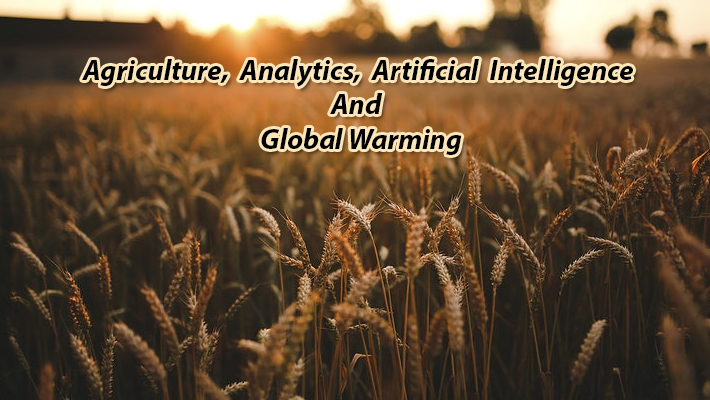
Did you know that globally, agriculture contributes about 25 to 35% of the total carbon dioxide emitted into the atmosphere? That is higher than the total CO2 emitted by air, rail, road, and sea modes of transport. In other words, the growing of grains, for the production of food is responsible for a third of global warming. With the growing population, both the demand for food and the decibel levels of the alarms and cries to reduce carbon emissions are increasing. What can be done? If emission cannot be reduced, can we recapture what was emitted? That is the idea of carbon sequestration, abbreviated as CCS; it denotes Carbon Control Sequestration or Carbon Capture Storage or a combination of these words.
Indigo Agriculture, a company based in Boston recently launched the ‘Terraton Initiative’ – a project to capture a trillion metric tons of Carbon dioxide from atmosphere. Based on the study conducted by National Oceanic and Atmospheric Administration, Indigo opines that if farmers across the globe can sequester and increase the carbon content in the soil by an average of 0.5%, that would tantamount to undoing all the CO2 released since Industrial Revolution i.e., removal of more than a trillion tons of CO2from the atmosphere.
TRADITIONAL AGRICULTURE
Farmers traditionally till the soil, plant, use synthetic fertilizers, pesticides, and practice crop rotation. All these increase CO2 in the atmosphere and reduce the ability of soil to store CO2, water and nutrients. After harvest, they bring their grains and dump them into silos. Each farmer does the same and there is no way to distinguish corn grown by John from that by Jane. They all sell at the same price irrespective of the quality, seed variety, and type of farming. This does not provide any incentive to the farmers. The end consumers also do not have any choice in buying, by considering the type of grains (protein-rich, milling quality) or the method of farming (organic, GM, non-organic etc.) or geographical location (southern states, north-western states etc.).
Indigo innovatively addressed the twin aspects by giving an identity to each crop from a farmer (by specifying the quality, farming method, etc.) and by introducing new practices to address carbon emissions. They created a marketplace to connect the farmers and buyers.
In it, the farmers can specify the attributes of their produce along with the price, and buyers can choose what the end consumers need. In addition, the intermediaries (middlemen) are eliminated thereby reducing the cost, bringing in total transparency, increasing efficiency and broadening the access. From the perspective of the farmers (sellers), they can choose the buyer by considering the bid value, or buyer location, or payment terms. The buyers can buy considering their customers’ preferences. This reduces the cost of supply chain, guarantees quality and increases farmers’ profits. As an add-on service, Indigo also facilitates testing of the grains, and their transport using Indigo Transport and payment via its portal. Thus, the marketplace serves as a “one-stop-shop” for buyers. They can choose, buy and have it delivered.
By adopting ‘regenerative agriculture’, - no chemicals, minimal tilling and rotational grazing of livestock – carbon can be sequestered and stored in the soil for a long time. CO2 released earlier is removed from the atmosphere. This reversal mitigates the impact of emissions.
Hence, Indigo launched Indigo Carbon, as a component of the marketplace, for farmers to earn money by participating in the carbon sequestration project. Indigo’s agronomists will visit the farms and assist the farmers to adopt regenerative practices. Indigo will offer farmers US $ 15 per ton of carbon dioxide sequestered. While machines can suck CO2 from the air at a cost of about US $ 100 per metric ton, the same can be achieved, by changes in farming at a much lower cost.
Indigo in partnership with Ecosystem Services Market Consortium, The Rodale Institute and the Soil Health Institute, all in USA, is encouraging farmers to join this initiative. So far, it has enrolled about 120 farmers and has instrumented about 50,000 acres of farms. Measuring carbon sequestration in the soil and emission level in the farm is a tedious process. Indigo is trying to use satellite-imaging techniques to do the same. The company has developed software to capture more than a trillion, yes a trillion data points per day and analyse them using analytics and artificial intelligence.
Companies manufacturing food products, other businesses who want to use these “green or carbon-neutral grains”, non-profit organizations that support these initiatives, insurance companies, and angel investors can also be part of this marketplace. Indigo guarantees the quality of the product and certifies the adoption of best practices to enhance carbon sequestration. Anheuser-Busch, has struck the first deal with Indigo to buy about 2.2 million bushels of rice. Indigo is confident that more such deals will come through soon.
While all this is very rosy, a few believe that it is impossible to sequester 1 trillion tons of CO2 and by altering agricultural practices, over a few decades, a maximum of only 100-200 billion tons of CO2can be removed. They feel that other steps are necessary to address this problem of global warming. Well time will tell who is right.







